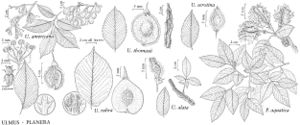Ulmus
Sp. Pl. 1: 225. 175.
Gen. Pl. ed. 5, 106. 1754.
| Taxon | Illustrator ⠉ | |
|---|---|---|
 | Ulmus serotina Ulmus alata Ulmus americana Planera aquatica Ulmus thomasii Ulmus rubra | John Myers John Myers John Myers John Myers John Myers John Myers |
Trees, less often shrubs, to 35 m; crowns variable. Bark gray, brown, or olive to reddish, tan, or orange, deeply furrowed, sometimes with plates (smooth when young in Ulmus glabra). Branches unarmed, slender to stout, some with corky wings; twigs glabrous to pubescent. Leaves sometimes tardily deciduous; stipules falling early. Leaf-blade ovate to obovate or elliptic, base usually oblique, sometimes cordate or rounded to cuneate, margins serrate to doubly serrate; venation pinnate. Inflorescences fascicles, racemes, or cymes, pedunculate or subsessile, subtended by 2 bracts. Flowers on branches of previous season, appearing in spring before leaves or in fall, bisexual, pedicellate or sessile; calyx 3-9-lobed; stamens 3-9; styles persistent, deeply 2-lobed. Fruits samaras, usually flattened, membranously winged. x = 14.
Distribution
Temperate regions, Northern Hemisphere, most in Eurasia
Discussion
Species 20-40 (10 in the flora).
A recent chloroplast DNA study (S. J. Wiegrefe et al. 1994) has led to the proposal of a new subgeneric and sectional classification of elms. The chloroplast DNA data are supported by morphologic, chemical, and nuclear ribosomal DNA evidence and indicate that the "rock" or hard elms (Ulmus serotina, U. thomasii, U. crassifolia, and U. alata) are more closely related than indicated by previous subgeneric treatments (C. K. Schneider 1916; I. A. Grudzinskaya 1980).
Most identification manuals include the introduced species, Ulmus glabra, U. procera, and U. parvifolia, and indicate that they are frequently naturalized. That may we. Available herbarium specimens are often inadequately labeled or do not reflect current occurrences. Ease of naturalization can be neither corroborated nor disproved. I include the three species in this treatment because they are known to persist and sometimes naturalize locally where the species have been planted. Extensive field work and collection of U. glabra and U. procera are needed to document their naturalized distributions. Ulmus parvifolia has been widely planted in groves and hedgerows in the Midwest and might well be expected to have become naturalized in more rural settings (S. Shetler, pers. comm., 1995).
Street and field elms throughout much of North America have been killed by Dutch elm disease. The pathogen responsible for the disease is Ceratocystis ulmi, a fungus native to Europe that was first discovered in North America in Colorado in the 1930s. Since the rapid spread of the disease in the 1960s, much research has been devoted to development of disease-resistant elms (R. J. Stipes and R. J. Campana 1981). Various hybridization projects, including cloning of disease-resistant elms by the American Research Institute, have been started across the country. Ulmus parvifolia and U. pumila have varying degrees of disease resistance and are utilized as shade trees or in breeding programs (see U. pumila below). Apparently Dutch elm disease also affects U. parviflora, U. glabra, and U. procera; certainly the latter two species are more common as seedlings than as trees.
Selected References
None.
Lower Taxa
Key
| 1 | Flowers appearing in late summer–fall. | > 2 |
| 1 | Flowers appearing in winter–early summer. | > 4 |
| 2 | Inflorescences long, to 5 cm, racemose, 8–12-flowered. | Ulmus serotina |
| 2 | Inflorescences short, much less than 5 cm, fasciculate, mostly 2-5-flowered. | > 3 |
| 3 | Calyx lobes 6–9, hairy | Ulmus crassifolia |
| 3 | Calyx lobes (3-)4-5, glabrous. | Ulmus parvifolia |
| 4 | Flowers on slender, drooping pedicels, in racemose cymes to 5 cm, long-pendulous; samaras pubescent and margins short-ciliate; seeds not thickened, inflated. | Ulmus thomasii |
| 4 | Flowers clustered in short racemes or dense fascicles usually less than 2.5 cm; samaras pubescent or marginally ciliate, not both, or glabrous; seeds thickened, not inflated. | > 5 |
| 5 | Flowers and fruits drooping on elongate pedicels or in short racemes; samaras marginally ciliate. | > 6 |
| 5 | Flowers and fruits sessile or subsessile, not pendulous, in dense fascicles, not racemes, samaras not marginally ciliate. | > 7 |
| 6 | Inflorescences in short racemes, not pendulous; calyx deeply lobed, symmetric; samaras lanceolate to oblong-elliptic, cilia white, 1–2 mm. | Ulmus alata |
| 6 | Inflorescences pendulous fascicles; calyx shallowly lobed, slightly asymmetric; samaras ovate, cilia yellow to white, 1 mm or less. | Ulmus americana |
| 7 | Calyx glabrous; samaras glabrous. | Ulmus pumila |
| 7 | Calyx pubescent; samaras pubescent, sometimes only on apical margin. | > 8 |
| 8 | Calyx villous; samaras mostly glabrous, apex marginally pubescent. | Ulmus procera |
| 8 | Calyx reddish pubescent; samaras pubescent. | > 9 |
| 9 | Calyx shallowly lobed; samaras pubescent on body only. | Ulmus rubra |
| 9 | Calyx lobed at least halfway; samaras pubescent only on central vein of wing. | Ulmus glabra |